Matters needing attention in safe operation of jet mill
Jet mills are becoming more and more popular in the powder industry, ranging from chemicals and mining to new energy sources, polymer materials, metals, superhard materials, medicines and foods, etc. Including rare earths, magnetic materials, ceramic materials, refractory materials, and light-emitting reflective materials all have applications in jet milling.
![]()
The following points should be paid attention to in the safe operation of jet mill:
1. Before starting the jet mill, check whether the various parts of the equipment are complete, and make sure that the parts are not loose, and the equipment can be started after confirming that it is correct.
2. The electric box and the motor must be grounded.
3. When the equipment is started, it is forbidden to touch any rotating parts, and it is forbidden to put your hands on the discharge port to prevent accidents or personal injury.
4. It is forbidden to do equipment maintenance and maintenance work under the condition of electrification and air.
Boot sequence:
1. Turn on the cooling water and start the air compressor. After 2-3 minutes of no-load operation, it is in normal operation.
2. Start the freeze dryer (the cooling water is connected with the cooling water of the air compressor).
3. The air compressor and freeze dryer work normally. After the air pressure reaches 0.7Mpa-1Mpa, start the host, adjust to the required speed, and then start the fan.
4. Before opening the main air pipe valve of the jet mill, adjust the air seal pressure of the motor bearing from 0.03Mpa to 0.05Mpa. After checking the above contents, start feeding and crushing.
5. Adjust the pulse air pressure of the dust collector to about 0.4Mpa.
6. When adjusting the thickness or fineness of the material according to the needs, the speed of the main machine's grading wheel can be adjusted: low coarse and high fine.
7. In the discharging process after crushing the material, tap the outer wall of the conveying pipe, cyclone and dust collector regularly with a leather hammer to avoid closing the contaminated material, causing the pipe to block and affecting the normal discharging.
Stop sequence (after stopping feeding):
1. Turn off the main air pipe valve. After the compressor is depressurized, turn off the air compressor power supply, turn off the freeze dryer, and then turn off the induced draft fan. When the rotation speed of the induced draft fan drops below half, turn off the inverter, turn off the dust collector, and turn off unloading. valve.
2. When the temperature of the air compressor is lower than about 60°C, turn off the cooling water.
3. Regarding pulse dust removal: When the jet mill is shut down after work every day, let the pulse meter work for 5-10 minutes to wash off the powder adsorbed on the filter bag and keep the air flow unblocked.
The main application areas of talc
Talc is a filler for plastics second only to calcium carbonate, and the number of applications in plastics is more than 200,000 tons per year. As some of the physical and chemical properties of talc have been further understood, its application scope and The number is increasing dramatically.
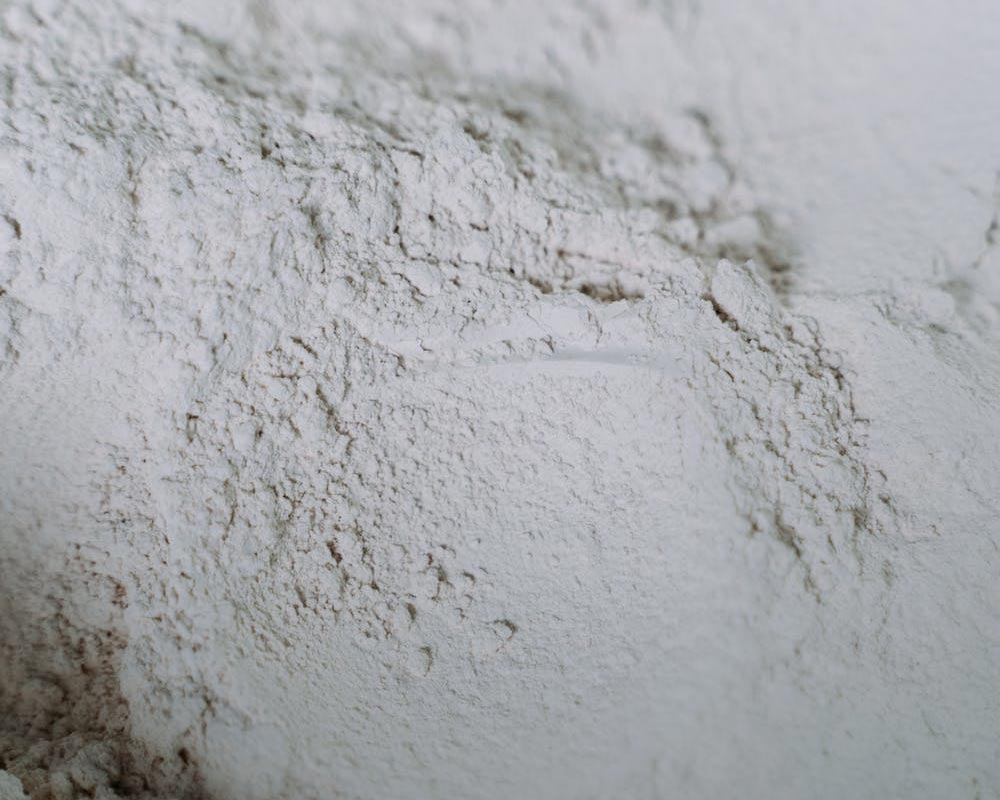
1) Use as a heat preservation agent for agricultural film
Silicon-containing minerals, such as mica, kaolin and talc, have a blocking and shielding effect on infrared rays. Adding an appropriate amount of this mineral powder to the agricultural greenhouse film can improve the resistance of the plastic film to infrared rays, thereby reducing the loss of heat in the shed to the outside of the shed in the form of infrared radiation at night, and improving the thermal insulation of the greenhouse.
The research results of the Light Industry Plastics Processing and Application Research Institute in the early 1990s show that:
①When mica powder, kaolin, talc powder and light calcium carbonate have the same filling amount (close in fineness and surface treatment), the mechanical properties of polyethylene film are close to each other, and the mechanical properties of the film filled with kaolin and mica powder are better. a little better.
②The barrier effect of LDPE film filled with silicon-containing fillers on 7-25μm infrared is significantly better than that of inorganic fillers without Si-light calcium carbonate, while the infrared barriers of mica powder, kaolin and talc are similar.
③ Among the three fillers containing Si, the light transmittance of LDPE film filled with mica powder is the highest, and is close to that of pure LDPE plastic film, followed by kaolin and talc, but both are higher than the film filled with calcium carbonate.
Because talc is cheap and easy to handle, although its light transmittance and infrared light barrier properties are not as good as mica powder and kaolin, it can still maintain better light transmittance while improving its thermal insulation. Therefore, it has been used in agricultural plastic shed films. It is widely used. At present, agricultural film production plants use 1%-6% of ultra-fine talcum powder according to different types of film (aging-resistant film, double-proof film, multi-functional film, etc.).
2) Use as a nucleating agent
Crystalline polymers such as polyethylene (PE), polypropylene (PP), polyethylene terephthalate (PET), polyamide (PA), etc., during the cooling and shaping process after melting, some macromolecules The arrangement is ordered, which is called crystallization.
Crystallization not only requires a certain temperature and cooling rate, but also requires the generation of crystal nuclei first, followed by crystal growth. The nucleating agent has two main functions. One is to increase the total crystallization rate, which can ensure that the molten polymer solidifies more quickly during the cooling process, thereby shortening the injection molding cycle cycle and improving work efficiency; Tensile strength, heat distortion temperature and hardness are all enhanced under the action of nucleating agent, transparency increases and turbidity decreases.
Talcum powder is used as a nucleating agent for PE or PP. First of all, the particles are required to be small. The smaller the particle size, the more the number of particles, which means the more crystal centers. The more crystals grown at the same time, the smaller the size of the crystal itself, and the better the performance of the entire material. At the same time, it is also required that the dispersion of the stone powder in the molten state is as thorough as possible, and the agglomeration phenomenon is as slight as possible.
3) Transparent filler masterbatch with talc as the main filler
Although the use of calcium carbonate in the plastic film can reduce the cost, when the amount is large, the transparency of the film is greatly affected, causing misunderstandings by some users. In response to this situation, the transparent filler masterbatch has made significant improvements in filler selection and processing technology, which greatly improved the transparency of the PE film.
Article source: China Powder Network
What problems should be paid attention to in powder surface modification
Powder surface modification refers to the use of physical, chemical, mechanical and other methods to treat the surface or interface of powder materials, and purposefully change the chemical properties of the surface of powder materials to meet the development of modern new materials, new processes and new technologies. need. It is a new technology that integrates powder processing, material processing, material properties, chemicals, and machinery.
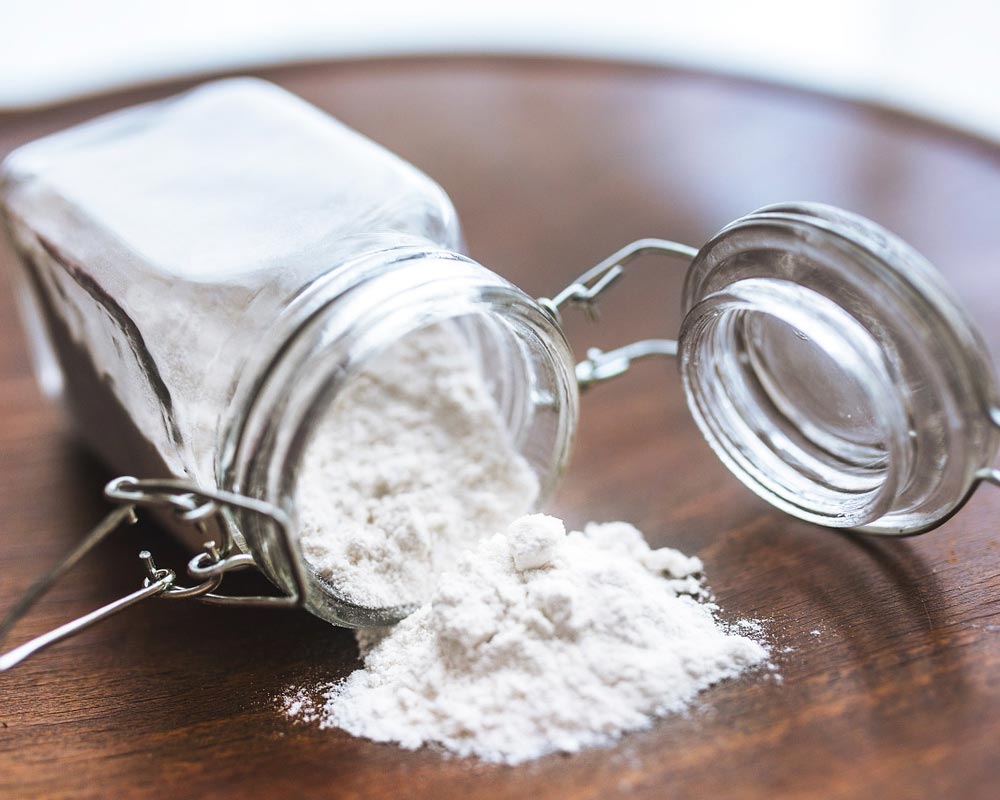
The following aspects should be paid attention to in the work of powder surface modification.
- The principle and method of powder surface modification
(1) The relationship between surface or interface properties and their application performance
(2) The mechanism and model of action between the surface or interface and the surface modifier or treatment agent
(3) The basic principles or theoretical basis of various surface modification methods, including the thermodynamics and kinetics of the surface modification process, simulation and chemical calculations, etc.
- Surface modifier and its formula
(1) The relationship between type, structure, molecular weight, active group and its application performance or function
(2) Mechanism and model of action with powder surface and composite materials
(3) Dosage and method of use
(4) Preparation or synthesis of new and special surface modifiers
- Surface modification process and equipment
(1) Process flow and process conditions for surface modification of powders of different types and uses
(2) Surface modification formulas of different types and different uses of powder
(3) Factors affecting the effect of surface modification
(4) Research and development of high-performance and special modified equipment
- Process control and product characterization and detection technology
(1) Monitoring technology such as process temperature, concentration, acidity, time and surface modifier dosage, surface coverage rate or coating thickness
(2) Characterization and detection (direct detection and characterization) methods and instruments of surface modified products;
(3) Correspondence between control parameters and indicators and intelligent control of the process.
Article source: China Powder Network
Mineral fillers and their role in coatings
Filler is also called filler, which is a type of material added to materials (such as plastic, rubber, paper, paint, etc.) for filling. It can reduce costs, improve performance, and improve process characteristics of materials.
Fillers can be divided into two types: one is to reduce costs by adding cheap materials to higher-priced materials and does not change the material properties of inert fillers; the other is functional fillers with special functions, such as electricity Insulating, conductive, magnetic, flame-retardant, anti-static and reinforcing, etc., the material properties can be improved after being added.
Classification of mineral fillers
Fillers have a wide range of applications, a wide variety of varieties, and a variety of classification methods. According to the material composition, it is divided into three categories: organic fillers and inorganic fillers, or mineral fillers, plant fillers, and synthetic fillers.
- Classified according to the geometric form of the filler
Particles are in the form of fillers, and the shape of the particles is not very regular, but the geometric shapes of different fillers have significant differences. The particle shape of different fillers has a significant impact on the performance of the product.
Morphological classification of mineral examples, particle geometry comparison
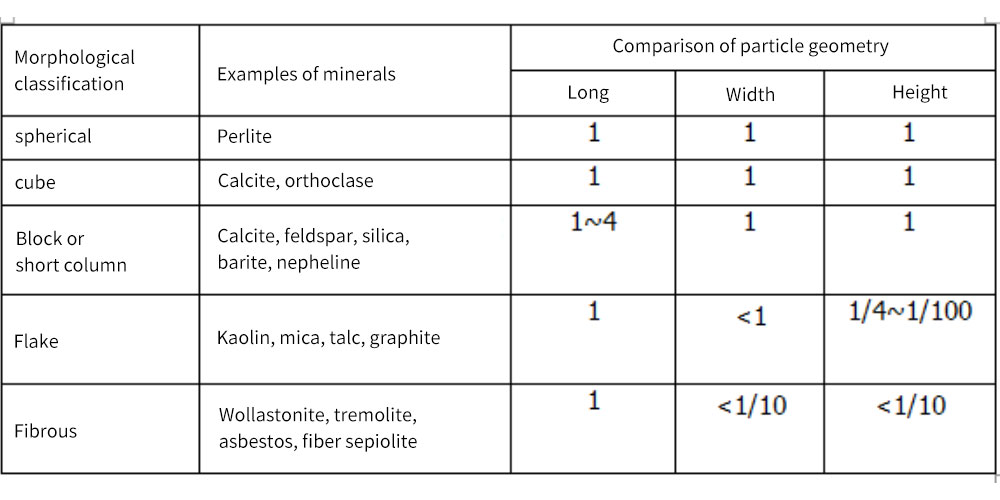
- Classified according to the chemical composition of the filler
In filler modification, the chemical composition of the filler determines the essence of the filler, especially when the material is given functionality, the chemical composition of the filler plays a decisive role. American scholar Hurlbut divides the chemical composition of fillers into four categories: oxide, salt, elemental substance and organic matter.
- Classified by filler application
There are many kinds of minerals that can be used as mineral fillers, and they have a wide range of uses. According to the application fields of fillers, they can be divided into more than 10 kinds of fillers such as plastic fillers, rubber fillers, paper fillers, paint fillers, and paint fillers.
The role of fillers in coatings:
1. Play the role of skeleton and filling in the paint, increase the thickness of the paint film, and make the paint film plump and solid.
2. It can adjust the rheological properties of the coating.
3. Improve the mechanical strength of the paint film, such as improving abrasion resistance and durability.
4. Adjust the optical properties of the coating and change the appearance of the coating film, such as matting.
5. The film-forming substance undergoes a chemical reaction to make it into a whole, so that the coating film can effectively block the penetration of light, improve its water resistance and weather resistance, and extend the service life of the coating film.
6. As a filler in coatings, it can reduce the amount of resin and reduce production costs.
7. It assists the chemical properties of the coating film, such as enhancing anti-rust, moisture resistance, flame retardancy, etc.
The oil absorption value (g/100g) of non-metallic mineral fillers commonly used in coatings.
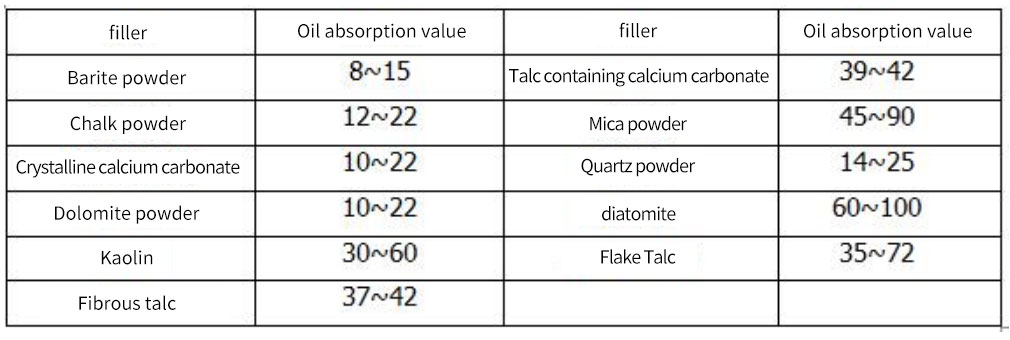
The fillers commonly used in coatings are calcium carbonate (heavy calcium, light calcium), barite powder (barium sulfate), talc powder, kaolin (porcelain soil), porous powdered quartz (silica), white carbon black, precipitated barium sulfate, Mica powder, wollastonite, bentonite, etc.
Calcium carbonate
Calcium carbonate is an important filler in paint production. Calcium carbonate plays the role of filling the framework and bottom plate (steel plate, wood) in the paint film, and enhances the deposition and permeability of the paint film.
Talcum powder
Talc is a universal filler in solvent-based coatings. It is currently used in various primers, intermediate coatings, road marking paints, industrial coatings and architectural coatings for internal and external use.
Kaolin
Kaolin is one of the fillers widely used in foreign coatings industry. Kaolin commonly used in coatings includes ultrafine kaolin, calcined kaolin, activated kaolin (surface modification treatment), etc. Kaolin can be used in various coatings, but mainly water-based architectural coatings.
Graphite
Natural graphite can be used in steel structure maintenance coatings due to its flake structure and good hiding rate. Its good conductivity and black color make it suitable for use in electronic and computer electrical shielding coatings. This coating can contain up to 75% graphite. Another use is anti-static floor coatings. It can be used in heat-resistant coatings, primers, sealing coatings and water-resistant coatings. Because of its good light resistance, it can be used in automotive paints as an effect pigment.
Wollastonite
The main component of wollastonite is calcium metasilicate (CaSiO3), which has a needle-like structure, good brightness, refractive index (1.62) and relatively low oil absorption (20~26g/100g)
Wollastonite with needle-like structure (length-to-diameter ratio is 10:1~20:1) can act as a smoothing agent in coatings, improve the mechanical strength of the coating film, and sometimes replace harmful asbestos in reinforced coatings. In coatings, it is generally used for relatively fine-grained (such as 325 mesh) and fine-grained (10μm) wollastonite powder, because it is beneficial to the hiding power of the coating. It can be used for oil-based architectural coatings, sound-absorbing (sound insulation) coatings, road marking paints, polyvinyl acetate latex paints, etc. Surface-treated wollastonite can be used in industrial alkyd, epoxy and other anti-corrosion coatings to improve the corrosion resistance of metal primers and partially replace active anti-rust pigments.
Article source: China Powder Network
What should be paid attention to in the early selection of air classifier
The jet classifier is the key equipment for the jet mill to control the particle size of the powder. It also has a strong application effect and has a very high utilization rate in all walks of life. Many customers do not know what standard to choose according to the air classifier before purchasing, and do not know whether the air classifier equipment has excellent performance according to which performance, which caused some doubts in the early stage of selection, and may also buy an inappropriate The airflow classifier. What should we pay attention to in the initial stage of air classifier selection.
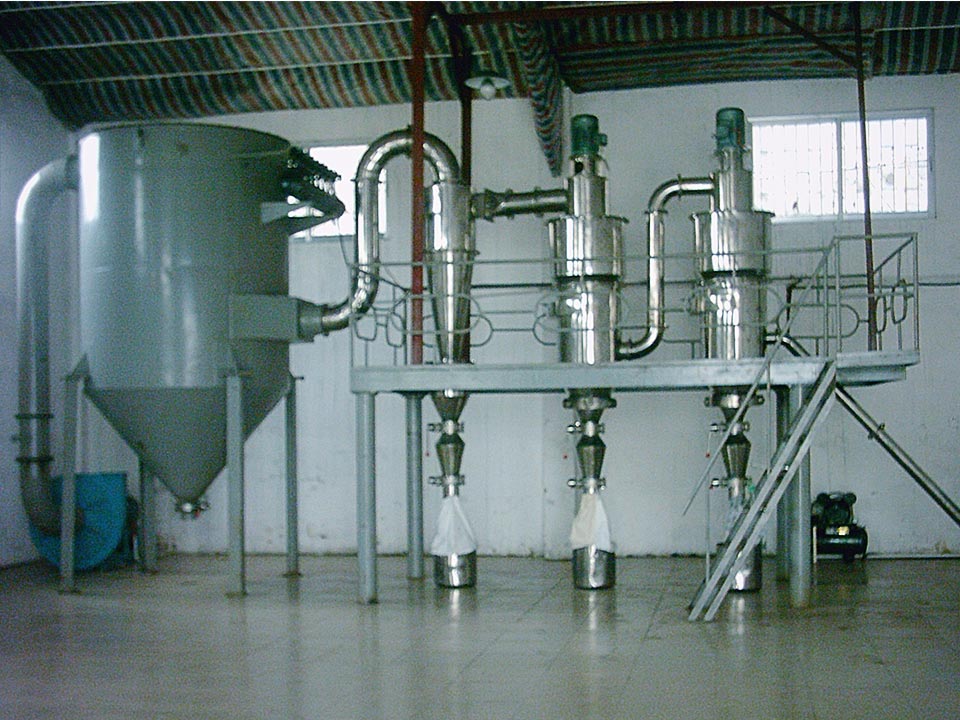
1. In the initial stage, you should understand and analyze the type, working principle, and performance characteristics of the selected equipment. Only by fully understanding the equipment can the selected equipment fully meet the production requirements.
2. After the selected equipment is put into production, it is necessary to know which parts are easy to wear, what is the replacement cycle of wearing parts, and whether the equipment needs auxiliary equipment during operation and what equipment is needed. Properly controlling these will save time and financial resources for future production.
3. Go to the production plant to inspect the equipment you want to buy. Because the equipment cost accounts for a large part when the factory is built, and the equipment is very complicated from design to finished product, the equipment manufacturer cannot fully introduce it. The equipment technical indicators given are only for reference when equipment selection, and cannot fully represent the equipment parameters.
4. When purchasing the main equipment of the classifier, relevant auxiliary equipment should be purchased as much as possible to complete the installation at one time, save time and proceed smoothly. Because the auxiliary equipment related to the host recommended by the equipment manufacturer has been practiced.
Application of silica in the fields of rubber, plastics and coatings
Silica is widely found in nature, and it is the main component of ceramics, glass and other non-metallic products. In particular, ultrafine silica has a large specific surface area, strong surface adsorption force, large surface energy, high chemical purity, good dispersion performance, thermal resistance, electrical resistance, etc. due to its small particle size. With its superior stability, reinforcement, thickening and thixotropy, it is widely used in rubber, plastics, coatings and other fields.
Rubber
- Application in vulcanized silicone rubber
The most widely used in rubber is fumed silica, which is mainly used as a reinforcement in vulcanized silicone rubber. Because the molecular chain of silicone rubber is very flexible and the molecular interaction between the chains is very weak, the strength of the unreinforced rubber is very weak and has no use value. It must be reinforced before it can be used.
- Application in medical rubber
The rubber with fumed silica as a reinforcing agent has good physical properties and has a wide range of applications in medical treatment. Its products involve various departments of medicine, such as craniocerebral surgery, ENT, anesthesiology, digestive system, cardiac surgery, and abdominal surgery. Surgery, urinary and reproductive system, etc. At the same time, sterile rubber medical gloves and disposable rubber examination gloves, medical hoses and medical silicone rubber catheters, medical bottle stoppers and artificial silicone rubber organs are also medical rubber products. As a medical rubber product, it must meet the requirements of non-toxic, chemically inert, non-allergenic, non-pathogenic, non-deformable, easy to process, and good anti-aging properties. Silicone rubber can basically meet these requirements.
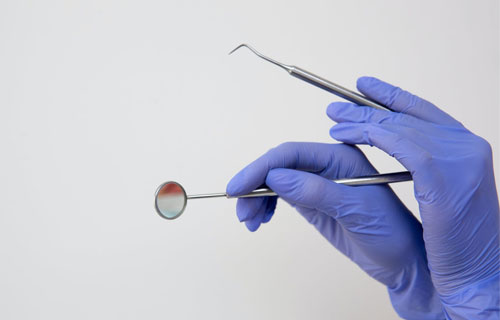
- Application in tire rubber
Compared with carbon black, nano-silica filled green tires have low rolling resistance and low fuel consumption, so they can replace the trend of carbon black filled car and truck tires. Now the concept of green tires has emerged. Green tires not only refer to fuel-efficient, safe, and low rolling resistance tires, but also meet the greening of raw materials and production processes.
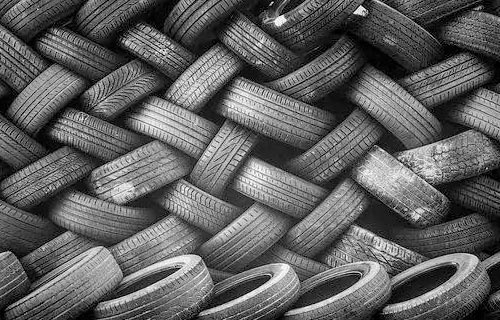
- Application in daily necessities
Nano-silica has good reinforcing properties and can improve the physical and mechanical properties of rubber. It is widely used in household appliances and rubber products in cultural and sports education.
- Role in hose tape and rubber shoes
Hose tape is two important parts in the rubber industry. In its production process, it is necessary to improve its wear resistance and fatigue resistance, so white carbon black needs to be added to meet the requirements of use.
In rubber shoes, especially in shoe soles, white carbon black can replace carbon black 100%, so rubber shoes are one of the industries that consumes more white carbon black. As a reinforcing filler, white carbon can enhance the wear resistance, tensile strength, tear strength and hardness of the sole, so it is widely used in the production of light-colored, colored translucent and transparent soles.
Plastic
- Application in thermoplastics
The traditional method of toughening plastics is to add rubber-like substances to the matrix. Although this method greatly improves the toughness of the material, it also greatly reduces the strength and processing performance of the material.
The toughening principle of fumed silica toughened plastics is the toughening of inorganic rigid particles. After it is added to the plastic, it can improve the toughness of the material without weakening the rigidity of the material, and even increase the rigidity of the material.
- Application in thermosetting plastics
Adding fumed silica to epoxy resin can significantly improve its brittleness, overcome the defects of material rigidity and strength reduction caused by the toughening of elastomers, and achieve the purpose of strengthening and toughening.
- As a flame retardant additive
Because fumed silica increases the strength of the carbon-silicon layer through the physical process in the condensed phase, it can prevent the transfer of heat and substances during combustion. By adding fumed silica to the EVA/MH blend and reducing the total filling amount, the elongation at break can be doubled when the flame retardant properties remain unchanged.
Coating
- Application in light-curing coatings
Ultraviolet curing coating (UVCC) is an environmentally friendly and energy-saving coating developed in the 1960s. Compared with traditional coatings, it has the characteristics of economy, environment friendliness, energy saving and high efficiency. Its disadvantages are that the equipment and raw materials are more expensive, the adhesion is poor, and it is easy to crack.
Filling the nano-silica into the ultraviolet curable coating can significantly increase the hardness of the coating after curing, and also improve the heat resistance. At the same time, it can improve the curing speed, hardness, adhesion and thermal stability of the UV-curable coating film at low temperature.
Studies have also shown that the presence of nano-silica can significantly improve the wear resistance, hardness, impact strength and flexibility of epoxy acrylate UV curable coatings.
- Application in architectural coatings
Nano-silica can effectively reduce the color difference of the coating caused by ultraviolet and infrared light irradiation, and improve the aging resistance of exterior wall coatings. It can also significantly enhance the hardness, adhesion and weather resistance of the coating, increase the viscosity and anti-settling ability of the coating, and enhance the stability of the coating.

- Application in color inkjet printing paper coating
Color inkjet printing paper can often be used in daily life, especially many large companies often use it for document printing. However, due to the micropores and cracks on the surface, it is necessary to have a primer to improve the performance of this paper. And if nano-silica is added to the primer, it can not only effectively improve the effect of the primer, but also improve the overall quality of the paper, and provide good absorption performance for the paper.
Moreover, if nano-silica is added to the pigment, a special coating for digital color inkjet printing paper with good performance can be made, which not only can make the coating load moderate, but also can effectively solve the problem of formaldehyde, the printing effect is good, and the material is easy. Yes, it can be said to be economical and useable.
- Application in plastic coatings
Nano-silica can also have a good promoting effect on the related thermal properties of polyethylene, not only can effectively improve the thermal stability of the composite material, but also the flame retardant performance will be greatly improved. It can be said that in the application of plastic coatings, nano-silica can fully improve the overall quality of the coating.
- Application in metal protective coatings
The use of silica is very extensive in the field of coatings, especially if nano silica is added to metal protective coatings, the quality of the coatings will also be further improved. Many researchers have tried nano-silica, and the results show that nano-silica can significantly enhance the strength of the carbon layer of metal protective coatings, and it will also increase the fire resistance of steel building materials.
Article source: China Powder Network
The safety of the inert gas protection jet mill is a major feature
The inert gas shielded jet mill is used in metal powder, easily oxidized raw materials, flammable and explosive raw materials, pharmaceutical ultrafine powder and other industries and raw materials that require inert gas protection. Typical materials are: cobalt powder, tungsten powder, iron powder, nickel powder, tantalum powder, selenium powder, fine spherical aluminum powder, neodymium iron boron, carbonyl iron powder, selenium powder, etc. The inert gas shielded airflow pulverizer is based on the fluidized bed airflow pulverization classifier, and uses nitrogen or carbon dioxide as the pulverizing working medium. It consists of nitrogen compression system, nitrogen filtration system, crushing system, classification system, collection system, feeding and unloading system, nitrogen purity test supplement system, nitrogen generation system and electrical control system.
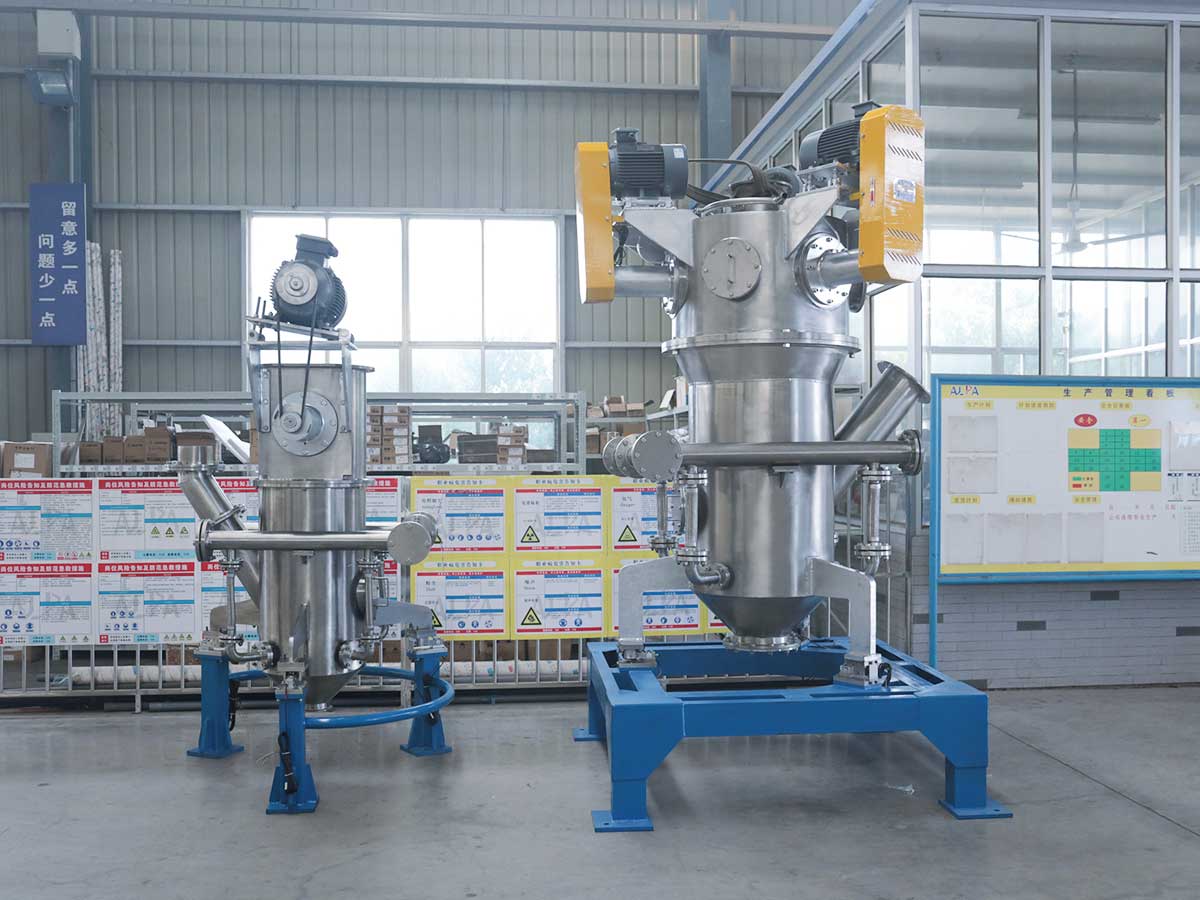
The entire production line of the inert gas protection jet mill equipment adopts fully enclosed negative pressure operation, and there will never be dust and dust pollution on the production site. Using PLC programming control, safety measures are multi-pronged and work in parallel, and only one of the measures is effective to prevent potential safety hazards. In terms of safety, the nitrogen-protected crushing equipment has the following characteristics:
- Isolate oxygen. During the process, an oxygen content tester is used to continuously monitor the oxygen content in the airflow, and when it exceeds a certain level, it will immediately add nitrogen to keep the oxygen content within the safety production standard.
- Control the concentration of gas and powder: the feeding system of the equipment is a fully enclosed, uniform speed device, which is programmed and controlled by the control cabinet. Fully enclosed plays the role of isolating oxygen, and the uniform speed controls the concentration of the material inside the added equipment, and the feeding speed can be set arbitrarily.
- Discharge static electricity in time and eliminate ignition sources: The special filter material with carbon steel wire used for the pulse blowback collector can eliminate static electricity in time and ensure that the pulse dust is clean and thorough. The equipment is all metal components, all grounded, in order to release the powder static electricity as much as possible.
- Circulating cooling: explosion-proof and dust-proof, emergency shutdown.
The above is the introduction of the safety advantages of the inert gas shielded jet mill. It is precisely because of these performance characteristics that the inert gas shielded jet mill has been applied in more industries, bringing new opportunities for the powder processing industry.
What are the development directions of supersonic jet mills?
At present, the development trend of powder granulation technology is toward the direction of large-scale equipment, compact structure, high-tech processing technology, diversified functions, high efficiency, and automation of control systems.
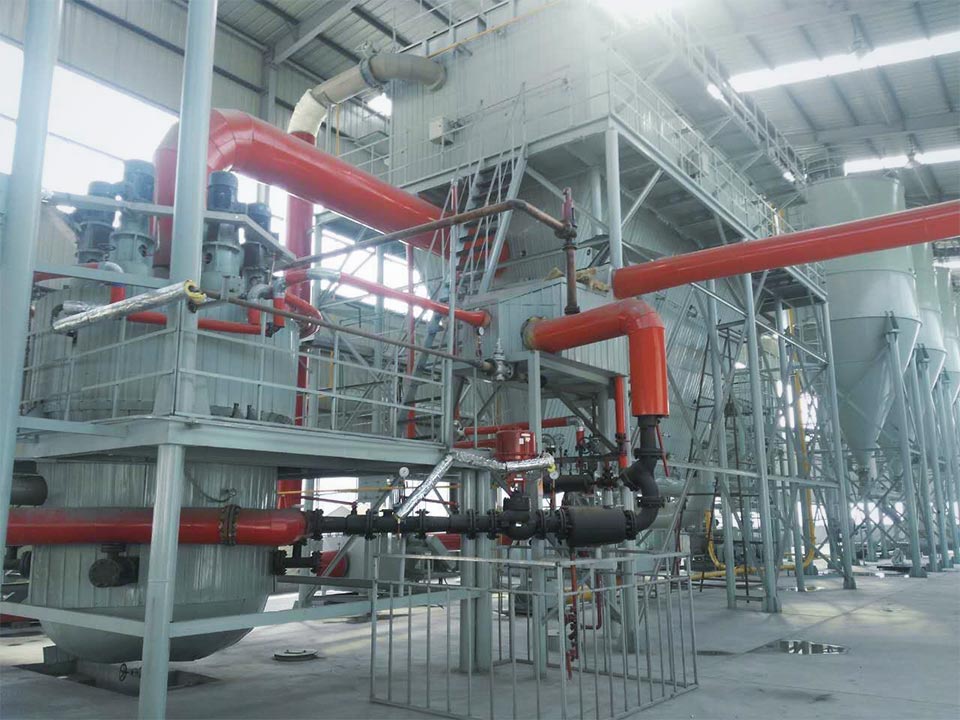
- Large-scale equipment
With the advancement of science and technology and the development of technology, the advantages of large-scale production equipment have become more and more obvious. At the same time, the application of CAD/CAM technology and precise stress analysis technology has promoted the development of mechanical structure design and processing and manufacturing technology. The large-scale granulation equipment provides a solid technical guarantee. At present, the powder granulation equipment is developing in the direction of large-scale, and the single-machine processing capacity of the super-large screw extruder can reach 25-30t/h. Taking the screw granulator as an example, the maximum screw diameter of the existing equipment is 240mm, and the single machine processing capacity exceeds 2t/h. A super-large screw granulator with a screw diameter of 380mm and a single machine processing capacity of more than 4t/h is under development; a rotary cold belt drop molding device, the width of the condensed steel belt under development is more than 1.5m, the equipment length exceeds 20m, and the single machine processing capacity More than 6t/h.
- Compact structure
Another development trend of jet milling equipment is compact structure. The structural design of the equipment is more reasonable, more compact, and more ergonomic, thereby reducing manufacturing costs, reducing floor space and improving labor efficiency. Take the screw granulator as an example, the direct connection of the motor replaces the traditional belt drive, making the equipment more compact and the transmission torque is greater; the variable pitch design is adopted, and the material conveying section, kneading and extrusion section are designed on one shaft , So that the conveying, kneading, and granulation can be completed at one time. These design concepts all represent the development direction of powder granulation equipment.
- High-tech processing technology
With the expansion of the application field of powder granulation equipment, traditional mechanical processing methods can no longer meet the needs of powder design technology. In the future, the processing technology of powder equipment will develop in the direction of high technology. For example, computer-aided design/manufacturing (CAD/CAM) technology is used to design and process the screw thread profile, special deep hole processing equipment is used to process the slender hole of the cold belt die distributor, and the five-axis CNC bed is used to realize the space twisting blade Profile processing, using plasma cutting machine, laser, EDM to process small aperture templates, using nano technology (nanometer coating) to process extrusion screws and rotating steel belts to solve material holding rods, product demoulding, etc.
- Diversified functions
The powder post-processing project is a system project that includes many unit operations in multiple disciplines and categories. It is required that the selection of powder granulation equipment should reduce the intermediate steps to save investment; at the same time, the market demand for products also requires production Manufacturers can provide products in various forms. This requires diversification of the functions of powder granulation equipment. Take the special extruder pelletizer for catalyst as an example. Based on the ordinary single-screw pelletizer, this machine has been specially designed and improved. It consists of two parts, extrusion and pelletizing, which can complete the extrusion and pelletizing in one machine. At the same time, by replacing the die template, granular products of different particle sizes and shapes can be obtained; the rotary belt molding device can realize hemispherical, flake, block, and stripe shapes by replacing parts such as distributors and overflow weirs. The production of products with different shapes, such as the shape, greatly facilitates users and truly realizes the diversification of functions.
- Efficiency and efficiency
With the improvement of people's awareness of energy saving, higher requirements are put forward for the efficiency of powder granulation equipment. This type of equipment is required not only to meet functional requirements, but also to be energy-saving, durable, and low in use, maintenance, and repair costs to reduce product costs. Take the crushing granulator as an example. If a traditional electromagnetic speed-regulating motor is used and an ordinary speed regulator is used to regulate the speed, the motor power needs to be 45kW. If the frequency conversion speed motor is used and the frequency converter is used to adjust the speed, it can save energy by more than 30% in actual use; the dual-axis differential continuous kneader, due to the specially designed high-efficiency kneading element, has an operating time compared with ordinary screw kneaders. Cut it in half and more than double the efficiency. The adoption of these technologies indicates that high efficiency has become one of the main goals pursued in the design of powder granulation equipment.
- Control system automation
With the advancement of science and technology and the development of automatic control technology, whether to adopt assembly line operation and automatic control has become an important indicator to measure the advancement of powder post-processing technology. The control system adopts automatic control, which can not only ensure the flow of the production process and reduce the labor intensity of the operators, but more importantly, it can ensure the accuracy and real-time feedback of the production process, improve product quality, and reduce equipment failure rate. Taking the rotary belt molding device as an example, if the computer DCS distributed control system is adopted, not only can the automatic operation of feeding, granulating, conveying, packaging and other processes be realized, but also through various temperature, pressure, flow, speed and other sensors, real-time Monitor system status. When the system status and process parameters change, timely feedback the changes, send out an alarm signal, and adjust the parameters according to the preset status to automatically adjust the system status to ensure the normal operation of the equipment. It is foreseeable that the automation of the control system will greatly improve the technical level of the powder granulator equipment and become the inevitable direction of the development of powder granulation equipment.
What are the application fields and characteristics of the air classifier?
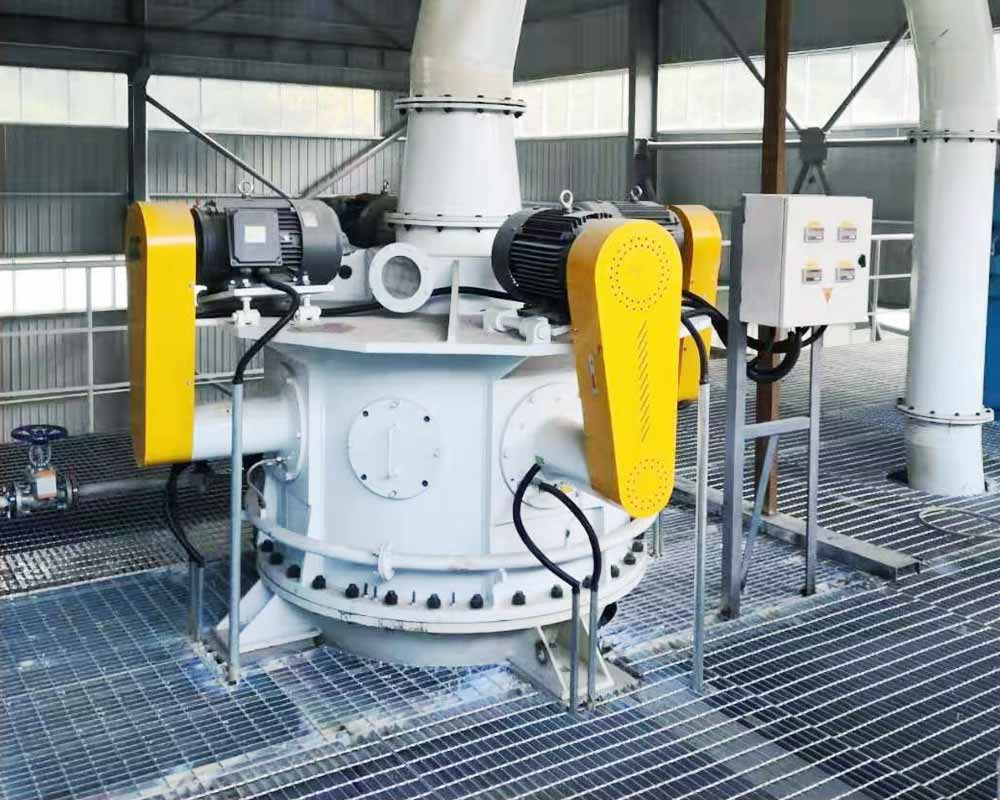
Application field of air classifier (material):
1. Superhard functional materials: silicon carbide, boron carbide, white corundum, brown corundum, diamond, zirconia, cerium oxide, high temperature alumina, silicon nitride, boron nitride, tourmaline, garnet, etc.
2. New chemical and polymer materials: magnesium hydroxide, aluminum hydroxide, aluminum oxide, carbon black, white carbon black, catalyst, titanium dioxide, activated carbon, ammonium polyphosphate, polyethylene wax, polyethylene, polypropylene, polyvinyl chloride , PTFE, epoxy resin, benzene aldehyde resin, fen aldehyde resin, paraffin wax, silica gel, titanium dioxide, dyes, flame retardants, blowing agents, zinc borate, etc.
3. Non-metallic minerals: calcite, dolomite, kaolin, talc, barite, quartz, graphite, coal powder, gangue, calcium carbonate (heavy, light), mica, vermiculite, pyrophyllite, spinel, Attapulgite, wollastonite, brucite, bentonite, limestone, diatomite, rectorite, sepiolite, petroleum coke, perlite, etc.
4. Metals and oxides: phosphorus iron, tantalum powder, selenium powder, spherical aluminum powder, molybdenum powder, high chromium iron, vanadium titanium, iron, aluminum, copper, zinc, tin, cobalt, nickel, magnesium, iron oxide, Alumina, zinc oxide, tin oxide, cobalt oxide, tungsten carbide, metallic silicon, stainless steel powder, alloy powder, etc.
5. New materials for batteries and copying: lithium cobalt oxide, cobalt oxide, lithium manganese oxide, manganese dioxide, lithium nickel cobalt oxide, lithium nickel manganese oxide, lithium carbonate, lithium iron phosphate, ternary materials, natural graphite, artificial graphite, Pitch coke, calcined petroleum coke, lithium hydroxide, cobalt tetroxide, ferrous oxalate, iron phosphate, carbon powder, etc.
6. Other materials: ceramic materials, refractory materials, electronic materials, magnetic materials, rare earth materials, phosphors, copy material powders, etc.
The performance characteristics of the air classifier:
1. It is suitable for the fine classification of dry micron products. It can classify spherical, flake, and needle-shaped particles, and can also classify particles of different densities.
2. The particle size of the graded products can reach D97: 8~150 microns, the product particle size is steplessly adjustable, and the variety is extremely convenient to change.
3. The classification efficiency (extraction rate) is 60% to 90%, and the classification efficiency of materials with good fluidity is high, otherwise the efficiency is reduced.
4. The vertical grading turbine device is adopted, with low speed, wear resistance, and low system power configuration.
5. Multi-stage classifiers can be used in series to produce products with multiple particle sizes at the same time.
6. It can be used in series with ball mill, vibration mill, Raymond mill and other grinding equipment to form a closed loop.
7. The control system adopts program control, the running status is displayed in real time, and the operation is simple.
8. The system runs under negative pressure, and the dust emission does not exceed 40mg/m³, and the equipment noise is not higher than 75dB(A) through the use of silencer measures.
Features of jet milling equipment
Air jet crushing equipment is used for various materials that cannot be crushed at room temperature. It is widely used in various chemicals, petrochemicals, machinery, ships, automotive industries, electronics industries, clothing, coatings, printing, engineering plastics, rubber, thermoplastic materials, hot melt Ultra-fine crushing of type materials, nylon, polyester, polyethylene, polypropylene, textiles, clothing, Chinese and Western medicinal materials, food industry and other products. The inert gas shielded airflow crushing system is a dry crushing system for flammable, explosive, and easily oxidizing materials. It consists of a nitrogen source, a compressor, a silo, a crushing host, a cyclone separator, and a dust collector. The material to be crushed enters the crushing area from the silo in a closed state, and the crushed material enters the classification area with the ascending airflow. The fine particles meeting the particle size requirements enter the cyclone separator and the dust collector to collect with the airflow, and the coarse particles return to the crushing area to continue. Shattered. The filtered inert gas is returned to the compressor suction port for recycling, meeting the requirements of environmental protection, energy saving, and clean production.
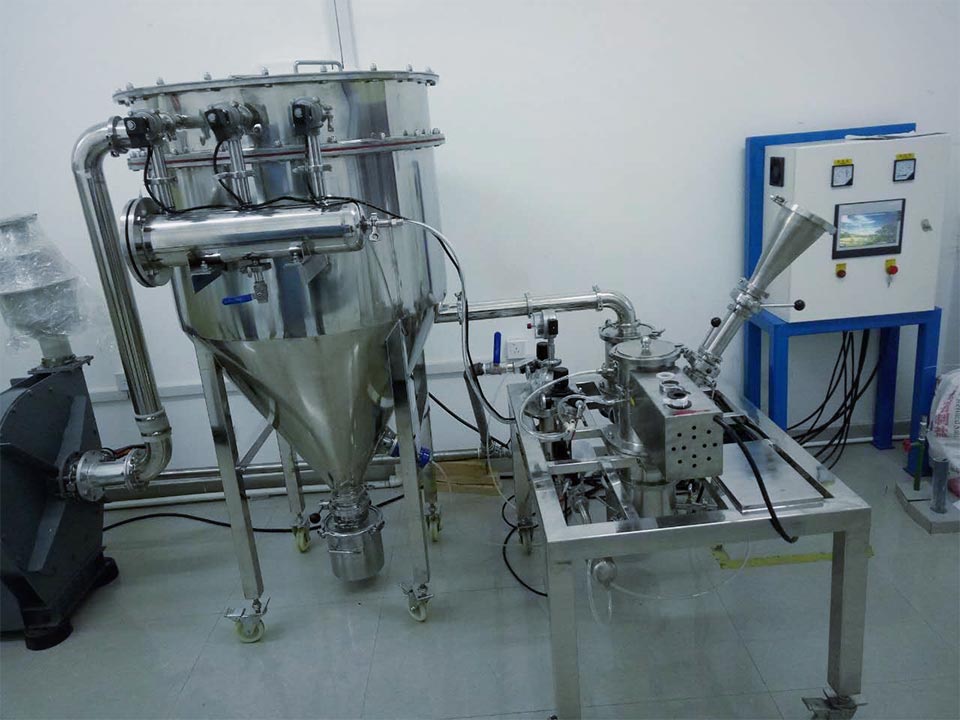
The working principle of the airflow crushing equipment: compressed air is filtered and dried, and then injected into the crushing chamber at a high speed through the Laval nozzle. The animal material is repeatedly collided and rubbed at the intersection of the high-pressure airflow and crushed. The crushed coarse and fine mixture plays a role in the negative pressure fan After reaching the classification area, the coarse and fine materials are separated under the strong centrifugal force generated by the high-speed rotating classification turbine. The materials that meet the particle size requirements are collected by the cyclone separator and dust collector through the classification wheel, and the coarse particles drop to the crushing area and continue to be crushed.
Features of jet milling equipment:
1. It is suitable for dry pulverization of various materials with Mohs hardness below 9, especially suitable for the pulverization of materials with high hardness, high purity and high added value.
2. The breakthrough of particle acceleration technology has greatly improved the crushing efficiency, reduced energy consumption, good particle shape, narrow particle size distribution and no large particles.
3. During the crushing process, the airflow temperature is reduced due to the rapid expansion of the airflow, which is especially suitable for the crushing of heat sensitive, low melting point, sugar-containing and volatile materials.
4. The crushing of materials by collision with each other is different from mechanical crushing which relies on the impact crushing of blades or hammers, etc., so the equipment is free from wear and the product is of high purity.
5. It can be used in series with a multi-stage classifier to produce products with multiple granularities at one time.
6. The equipment is compact in structure, easy to disassemble and clean, and the inner wall is smooth and has no dead corners.
7. The whole system is sealed and crushed, no dust, low noise, and the production process is clean and environmentally friendly.
8. The control system adopts program control, which is easy to operate.
9. Variable combined structure, compact structure, multi-purpose machine.
